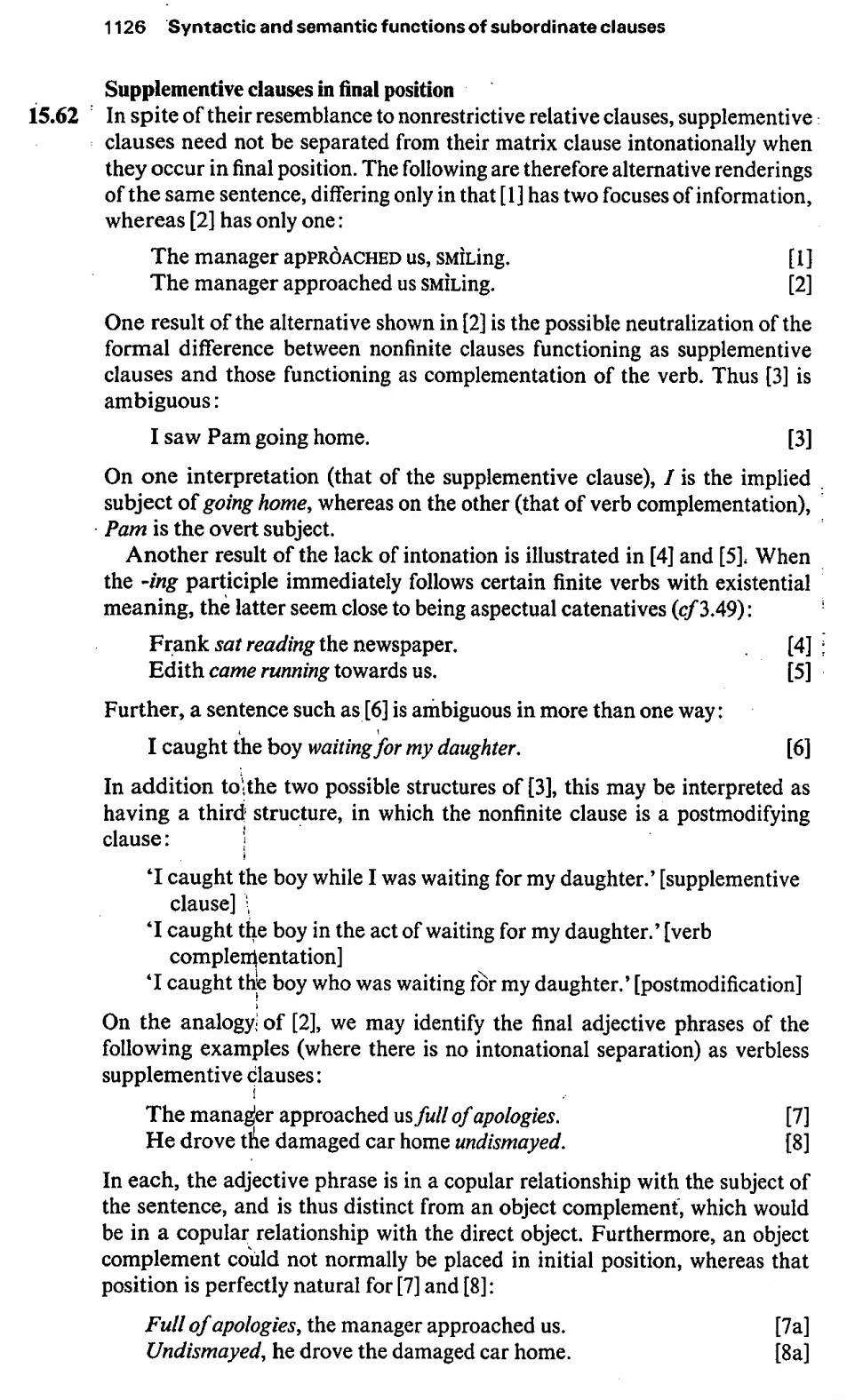我帮你复制一下该书的翻译版内容吧,可能对理解原文有些帮助。
要想清楚搞懂这个问题还是等曹老师、好题老师等大师来解答吧。


句尾现在分词短语的作用
下面是《英语语法大全》英文版P1126上的一部分内容,作者的有些叙述不好理解,我简化一下,只针对作者所举的含有句尾现在分词短语的例句,来说说我的理解,大家看对不对。
In spite of their resemblance to nonrestrictive relative clauses, supplementive clauses need not be separated from their matrix clause intonationally when they occur in final position. The following are therefore alternative renderings of the same sentence, differing only in that [1] has two focuses of information, whereas [2] has only one:
The manager apPROCHED us, SMILING. [1]
The manager approached us SMILING. [2]
One result of the alternative shown in [2] is the possible neutralization of the formal difference between nonfinite clauses functioning as supplementive clauses and those functioning as complementation of the verb. Thus [3] is ambiguous:
I saw Pam going home. [3]
On one interpretation (that of the supplementive clause), ‘I’ is the implied subject of ‘going home’, whereas on the other (that of verb complementation), ‘Pam’ is the overt subject.
Another result of the lack of intonation is illustrated in [4] and [5]. When the -ing participant immediately follows certain finite verbs with existential meaning, the latter seem close to being aspectual catenatives:
Frank sat reading the newspaper. [4]
Edith came running towards us. [5]
Further, a sentence such as [6] is ambiguous in more than one way:
I caught the boy waiting for my daughter. [6]
In addition to the two possible structures of [3, this may be interpreted as having a third structure, in which the nonfinite clause is a postmodifying clause:
‘I caught the boy while I was waiting for my daughter.’ [supplementive clause.
‘I caught the boy in the act of waiting for my daughter.’ [verb complementation]
‘I caught the boy who was waiting for my daughter.’ [postmodification]
我的理解:
The manager apPROCHED us, SMILING. [1]
The manager approached us SMILING. [2]
举这两个例子,作者想说,有的时候,位于句尾的现在分词短语前有没有停顿(书面加不加逗号)都一样,即[1]和[2]意思一样,现在分词短语都是增补性分句(即作状语),两者唯一的区别是:[1]有两个信息焦点,[2]有一个。
I saw Pam going home. [3]
针对这个例子,作者想说,类似[3]这样的句子,有没有停顿(逗号)意义就有不同了,会有两种解读:第一种,“I”是“going home”的隐含主语,也就是说现在分词短语going home是增补分句(即作状语);第二种,“Pam”是“going home”的显性主语,即现在分词短语going home是动词补足语。如果going home前有了停顿(逗号),则只有一种含义:going home是增补分句(即作状语)。
Frank sat reading the newspaper. [4]
Edith came running towards us. [5]
作者举这两个例子,又想说明,有的句子(谓语动词为存在动词),句尾现在分词短语前没有停顿(逗号)话,会让人感觉这是链接动词的用法,即类似I like eating fish.的用法。
I caught the boy waiting for my daughter. [6]
作者举这个例子,又想说明,有的句子,句尾分词短语前没有停顿(逗号)的话,分词短语的作用除了可作上面的提到的其中两种解读之外,还可以有第三种解读,即后置定语。
我不敢质疑大师,应该是我水平不够,我怎么感觉英文版的有些叙述特别绕,因而意思上不是特别清晰。
请各位老师不吝赐教!
我的理解:
【1】The manager apPROCHED us, SMILING. [1] 参考译文:这位经理走近了我们,在微笑。
【2】The manager approached us SMILING. [2] 参考译文:这位经理以微笑方式走近我们。
举这两个例子,作者想说,有的时候,位于句尾的现在分词短语前有没有停顿(书面加不加逗号)都一样,即[1]和[2]意思一样,现在分词短语都是增补性分句(即作状语),两者唯一的区别是:[1]有两个信息焦点,[2]有一个。
【1】解析:用逗号隔开现在分词相当于是:The manager approached us and smiled at us.
【2】解析:没有逗号隔开现在分词相当于是:The manager approached us in a way of smiling at us.
【3】I saw Pam going home. [3] 参考译文:我看见Pan正在回家。
针对这个例子,作者想说,类似[3]这样的句子,有没有停顿(逗号)意义就有不同了,会有两种解读:第一种,“I”是“going home”的隐含主语,也就是说现在分词短语going home是增补分句(即作状语);第二种,“Pam”是“going home”的显性主语,即现在分词短语going home是动词补足语。如果going home前有了停顿(逗号),则只有一种含义:going home是增补分句(即作状语)。
【3】解析:现在分词going home作宾语补足语,即see sb doing sth 看见某人正在做某事。
【4】Frank sat reading the newspaper. [4] 参考译文:Frank坐着在看报纸。
【4】解析:现在分词reading the newspaper 作方式/伴随状语 :描述的一个附加的动态画面,相当于是Frank was reading the newspaper when he sat.(现在分词短语作方式/伴随状语。)(主语同时发出/执行了2个动作行为:坐着sat为主要动作,reading the newspaper看报纸属于次要动作。)
【5】Edith came running towards us. [5] 参考译文:Edith 以朝我们跑来的方式过来的。
作者举这两个例子,又想说明,有的句子(谓语动词为存在动词),句尾现在分词短语前没有停顿(逗号)话,会让人感觉这是链接动词的用法,即类似I like eating fish.的用法。
【5】解析:running towards us现在分词作方式状语,即描述来的方式,即谓语动词came是以这种(跑的)方式发生的。即是以“向我们跑的方式来到的”
【6】I caught the boy waiting for my daughter. [6] 参考译文我发现这个男孩正在等我的女儿。
作者举这个例子,又想说明,有的句子,句尾分词短语前没有停顿(逗号)的话,分词短语的作用除了可作上面的提到的其中两种解读之外,还可以有第三种解读,即后置定语。
【6】解析:waiting for my daughter为现在分词作宾语补足语。catch sb doing sth 当场发现某人做某事。
如果觉得我的回答对您有用,请随意打赏。你的支持将鼓励我继续创作!

 《高考英语备考1号·速效编》
《高考英语备考1号·速效编》
 《高考英语备考1号·写作编》
《高考英语备考1号·写作编》
 《高中英语晨读晚记》
《高中英语晨读晚记》
 《高中英语错题笔记》
《高中英语错题笔记》
 《零起点考大学英语》
《零起点考大学英语》
